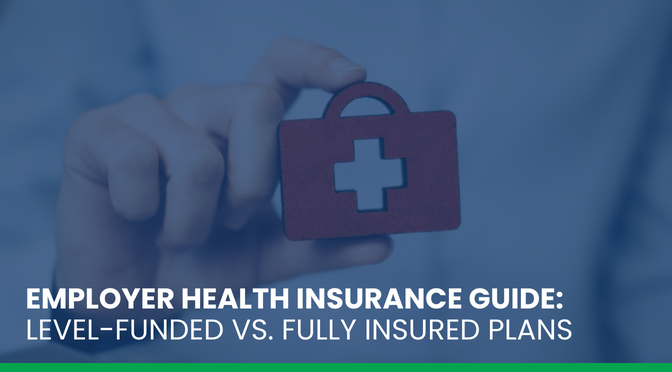You want to make sure you have the best health insurance plan for your business.
But it’s easy to get lost in the details.
You know you can’t skip the fine print. So, you read a paragraph over again trying to make sense of it.
I know where you are right now. I have seen that glazed look over people’s eyes many times. As an insurance agent, I often meet with business owners who get overwhelmed at this topic.
I’m here to help you!
I want to give you the big picture of two of the most common health insurance plans for small and medium size companies: Fully Insured and Level-Funded.
What Does it Mean to be Fully Insured?
Fully insured is what most companies with less than 300 employees used prior to ACA/Obamacare. The rules have changed, and now, fully insured plans operate much like the high-risk pool.
This plan is best for small businesses with less than 50 eligible employees with high claims.
This model is usually the most expensive type of coverage.
- Pricing – The pricing is determined by the age of employees participating in the plan, their home zip codes, and the health insurance plan you select.
- Equal Policies – The company down the street pays the identical price as your company. It is the same price for everyone on the same policy, that is the same age, living in the same geographic area.
- What’s Not Considered – The anticipated claims and the health of your employees is not considered in the pricing of this product.
How It Works:
The insurance carrier gives your company a monthly premium for the policy you purchased. You pay this amount for a year. Your “renewal” is then calculated, and you are offered a contract for the next 12 months.
With a fully insured policy, you never know the details.
You do not know the dollar amount that was paid in claims, or if you overpaid an insurance company, or if your employees spent more in claims than the premium paid.
On the fully insured policy, premiums are calculated to include all the people in your geographical area on this policy, and what they need to cover all the claims. Once the carrier determines this information, a plan is filed with the Department of Insurance for approval and your renewal has been established.
There are times when you may want this type of health insurance. It may be all you can get. There is no medical underwriting. You simply give your agent your census and they provide your premiums.
An Example – When this Plan is Right for You
Let’s suppose your group has 7 employees eligible for health insurance, and only 4 are taking the coverage. One of these 4 employees uses an expensive specialty drug like the kind you see on TV. Let’s assume its Humira with a cost of $6,400 PER MONTH.
Health insurance is an easy formula: Anticipated claims = base premium.
If you were on the different model of level-funding, then this drug at $6,400 per month would be $1,600 per person as your base premium. Most small businesses cannot afford these types of monthly premiums.
Most self-funded insurance carriers will decline to quote this company explaining they would not be competitive with a fully insured policy.
Therefore, a fully insured policy of sharing the cost of this company’s claims with all other employers in your area is by far going to be the least expensive option for this company.
Over 50 Eligible Employees
Things change if you have over 50 eligible employees.
On a fully insured product, your company may be asked for medical questionnaires from your employees. The monthly premium is calculated by a formula specific to your company, based on expected claims, age, location. The rates are specific to your company’s anticipated claims.
Insurance companies cannot decline your company; yet they will determine the rates based on expected claims for your specific employees.
All agents get the same price from the health insurance carriers.
The myth that one agent can get a better price is just that – a myth.
If an agent is presenting a lower price, then there is a difference between the two policies. It can be a subtle difference in benefits. Or the price could be different with the same insurance carrier and plan design, yet one agent provides a different census verses the other agent.
If an insurance agent claims that they can get a better price – then that’s a red flag. You simply need an agent who brings creative options within the confines you have provided.
What is a Level-Funded Insurance Plan?
Level-funded is what healthy companies have migrated to.
This model has a different approach partly to get around ACA/Obamacare regulations and taxes.
- Pricing – The financial part of this policy is dissected into your company’s expected claims, administrative costs, reinsurance, and agent commission to determine your monthly premium.
- Payments – You pay the same amount of money every month, and claims are automatically paid by the insurance company.
- Your Employees – Premiums are calculated based on your employees, their anticipated claims, age, gender, and location.
- You Know the Details – You can track what was paid.
- Refund – With most health insurance carriers, there is a refund should your company not spend all the claims dollars.
The key here – Control the claims and you control the premiums.
What is a Self-Funded Insurance Plan?
Self-funded health insurance is another insurance model with similarities to level-funding.
It requires more active cash-flow management.
The contract is created around your employee’s expected claims.
The pricing includes all the items mentioned above in level funded plans. However, instead of paying the same amount each month, you will pay the monthly administrative costs. Claims are paid separately, as incurred.
On either a bi-weekly or monthly schedule, a Third-Party Administrator (TPA) will present to your company an accounting of claims that have been processed and need to be paid. Your company will write a check for payment of these claims and the TPA will distribute payment to the medical providers.
The insurance company is not holding your money to pay a claim and then refunding what they did not pay in claims. You are holding your claims money and paying the claims as they are incurred.
Note: Premiums are generally going to increase every year because part of the premium renewal calculation is based on age. Age is a significant factor in determining premiums.
Level-Funded vs. Fully Insured
The biggest difference between the two models is how ACA/Obamacare rules apply.
The fully insured option is more expensive under ACA. It takes into account the same pool of people in your geographic area and age-group to make a consistent price point across the board.
The level-funded model skirts many of the ACA/Obamacare rules and taxes. The level-funded approach helps with cash flow with less taxes and is different in how claims are paid. The monthly premium is determined by your company’s expected claims, administrative costs, reinsurance, and agent commission.
One other difference between the models is that on the level-funded and self-funded products, you do not overpay an insurance company. You get a refund if you pay too much into the claims fund. You get reports on the ongoing claims costs throughout the year, so the renewals are not a surprise.
However, on the fully insured products, you do not know if you overpaid an insurance company or paid less than your claims cost.
What Works Best for You
Hopefully, this has given you more clarity on a topic that is normally overwhelming to employers. Once you understand the big picture, you will be able to customize a benefits package that works best for your company. I want to encourage you to seek a qualified insurance agent who can first listen to your needs and then be creative in finding solutions for you.










